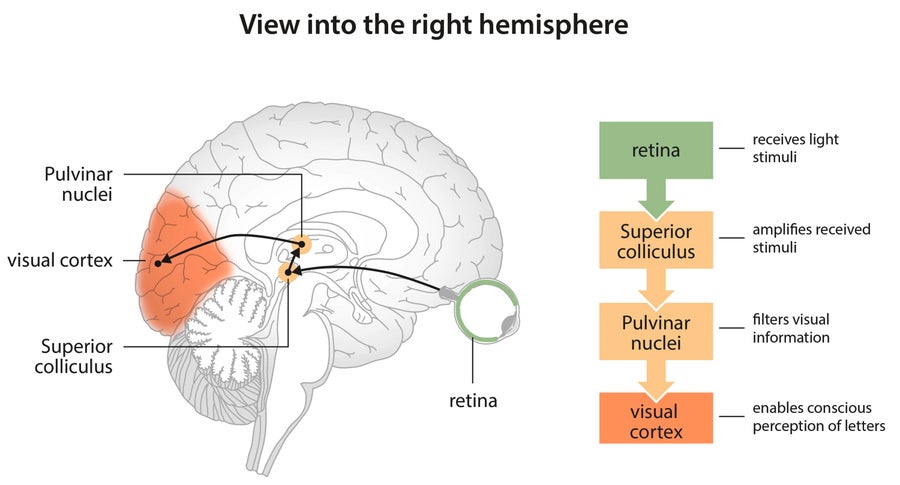This article was published in Scientific American’s former blog network and reflects the views of the author, not necessarily those of Scientific American
The brain did not evolve to read. It uses the neural muscle of pre-existing visual and language processing areas to enable us to take in works by Tolstoy and Tom Clancy. Reading, of course, begins in the first years of schooling, a time when these brain regions are still in development. What happens, though, when an adult starts learning after the age of 30? A study published May 24 in Science Advances turned up a few unexpected findings.
In the report, a broad-ranging group of researchers—from universities in Germany, India and the Netherlands—taught reading to 21 women, all about 30 years of age from near the city of Lucknow in northern India, comparing them to a placebo group of nine women. The majority of those who learned to read could not recognize a word of Hindi at the beginning of the study. After six months, the group had reached a first-grade proficiency level.
When the researchers conducted brain scans—using functional magnetic resonance imaging—they were startled. Areas deep below the wrinkled surface, the cortex, in the brains of the new learners had changed. Their results surprised them because most reading-related brain activity was thought to involve the cortex.
On supporting science journalism
If you're enjoying this article, consider supporting our award-winning journalism by subscribing. By purchasing a subscription you are helping to ensure the future of impactful stories about the discoveries and ideas shaping our world today.
The new research may overturn this presumption and may pertainpertain to child learners as well. After being filtered through the eyes, visual information may move first to evolutionarily ancient brain regions before being relayed to the visual and language areas of the cortex typically associated with reading.
Scientific American interviewed Falk Huettig of the Max Planck Institute for Psycholinguistics, the study’s senior author, to find out more. [An edited transcript follows.]
What impelled you to take up the question of what are the changes in the brain of an illiterate adult who acquires some degree of literacy?
The social implications of this kind of research are huge. Hundreds of millions of adults are completely illiterate across the world. But also in Western countries such as the United States there are millions of functional illiterates, that is people who struggle to read even very simple sentences. We need to understand how flexible the brains of adults are for acquiring a hugely complex skill such as reading later in life to be able to put together literacy programs that have the best chance of succeeding to help these people.
From a basic research point of view, working with illiterate people is also very rewarding. Writing is a very recent cultural invention if we look at the evolutionary history of our species. The first proper scripts were invented less than 6000 years ago. That means there is no reading area or reading network that could be specified in our genes. Looking at how cultural inventions change brain function and structures helps us to understand how the brain works on a fundamental level.
How did you set about organizing the study?
We needed to find adults who could not read at all to answer our research questions. We also wanted to use the latest technology to observe the changes in the brain. India was about the only place in the world where it was feasible to get this research done. India has made a lot of progress in increasing literacy levels but there are still large numbers of adults who cannot read even a single word today. At the same time modern MRI scanners are available at least in the big cities. Thus we got in touch with Indian colleagues to carry out the study.

Interconnected brain regions switch on when a person learns to read. Source: Max Planck Institute for Human Cognitive and Brain Sciences
Was it difficult to put together-if so, can you be specific?
The logistic challenges were quite immense. Although there are many illiterates in India they tend to live in the remote countryside far away from the big cities where the MRI scanners are. Even in India illiteracy is to some extent stigmatized and the ability to read and write is strongly connected to social class. We had to make sure that social factors could not influence the findings. We were grateful that a group of Dalit people, the most disadvantaged social group in India, were happy to take part. Brain scans were performed in the city of Lucknow, a three-hour taxi ride away from participants' homes.
What did you find, what did you expect to find and what surprised you about your ultimate results?
We expected to replicate previous findings that changes are limited to the outer layer of the brain, the cortex, which is known to adapt quickly to new challenges. We found the expected changes in the cortex but we also observed that the learning process leads to a reorganization that extends to deep brain structures in the thalamus and the brainstem. The relatively young phenomenon of human literacy therefore changes brain regions that are very old in evolutionary terms and already core parts of mice and other mammalian brains.
More precisely, we found that a part of the brainstem known as the superior colliculus, and the pulvinar, located in the thalamus, adapt the timing of their activity patterns to those of the visual cortex. These deep structures in the thalamus and brainstem help our visual cortex to filter important information from the flood of visual input even before we consciously perceive it. Interestingly, it seems that the more the signal timings between the two brain regions are aligned, the better the reading capabilities. It appears that these brain systems increasingly fine-tune their communication as learners become more and more proficient in reading
Do your results have any implications for disorders such as dyslexia?
The findings do not only provide hope for adult illiterates, they also shed new light on the possible cause of reading disorders such as dyslexia. One possible cause for the basic deficits observed in people with dyslexia has previously been attributed to dysfunctions of the thalamus. Since we found out that only a few months of reading training can modify the thalamus fundamentally, we have to look more closely atthis hypothesis. It could also be that affected people show different brain activity in the thalamus just because their visual system is less well trained than that of experienced readers. This means that these abnormalities can only be considered an innate cause of dyslexia if they show up prior to schooling. That's why only studies that assess children before they start to learn to read and follow them up for several years can bring clarity about the origins of reading disorders.
Here is a full list of researchers:
Michael A. Skeide, department of neuropsychology, Max Planck Institute for Human Cognitive and Brain Sciences; Uttam Kumar, Centre of Biomedical Research, Uttar Pradesh, India; Ramesh K. Mishra, University of Hyderabad, India and Centre for Behavioural and Cognitive Sciences, University of Allahabad, Uttar Pradesh, India; Viveka N. Tripathi, Centre for Behavioural and Cognitive Sciences, and department of psychology, University of Allahabad, Allahabad; Anupam Guleria, Centre of Biomedical Research, Uttar Pradesh, India; Jay P. Singh, Centre for Behavioural and Cognitive Sciences, University of Allahabad; Frank Eisner, Donders Institute, Radboud University, Nijmegen, Netherlands and Falk Huettig, psychology of language department, Max Planck Institute for Psycholinguistics, Nijmegen, Netherlands.
